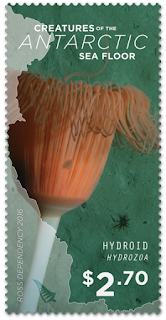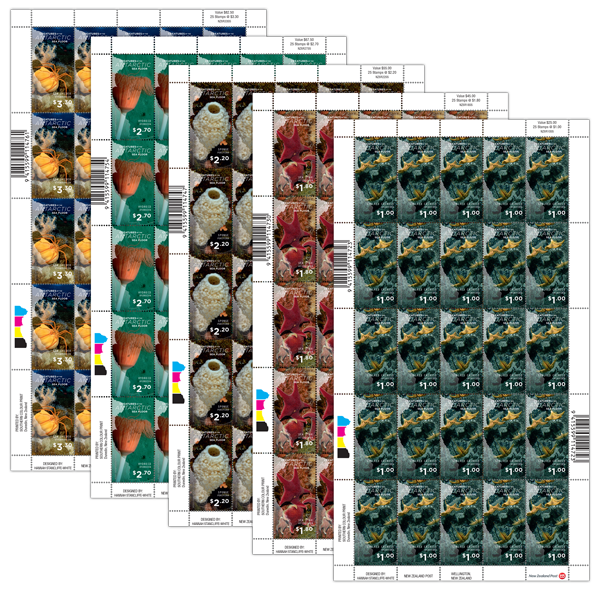 Covered in ice for much of the year, and with seawater temperatures below zero, who would guess that beneath the surface the Ross Sea is a world teeming with life?
Covered in ice for much of the year, and with seawater temperatures below zero, who would guess that beneath the surface the Ross Sea is a world teeming with life?The Ross Sea seafloor is home to some of the most diverse invertebrate communities in the Southern Ocean. In stark contrast to the animals living above the ice, the sea floor creatures are often colourful and definitely unique. More than half of Antarctic marine species cannot be found anywhere else. They generally grow slowly, are often very large, and can also live for a long time.
These spectacular seafloor animals are very well adapted to life in this cold, often dark, and unique environment, where conditions have not changed for millions of years, and where they have evolved in isolation.
Because of the stable and narrow range of conditions they experience in their habitats now, there is concern about how these animals will survive in a rapidly changing ocean. A great example is how they might cope with temperatures warming above those they currently live in, and the modifications that this will cause to their wider ecosystem. Yet a warming ocean may also enable some organisms to expand their distributions and the introduction of new species may also bring challenges to these isolated communities.
$1.00 – Stalked crinoid.
These beautiful stalked crinoids (sea lilies) are found on seamounts north of the Ross Sea. They are suspension feeders, using their stalks to raise them into the currents above the sea floor. Their feather-like arms trap fine food particles in the water and transfer the food to their mouths at the centre of the feeding arms.
$1.80 – Sea star. $2.20 - Sponge.
$1.80 – Sea Star.
Odontaster Validus is the most common sea star of the Antarctic and is found in large numbers in the Ross Sea, and also on some of the seamounts north of the Ross Sea. This bright pink species has a voracious appetite – it actively hunts prey of many types, but will also scavenge the remains of other sea creatures and can even feed on plankton.
$2.20 - Sponge.
Haliclona Dancoi is a relatively common Antarctic sponge that forms frilly, lumpy single or multiple vases. Food and oxygen are captured from seawater that is sucked in through tiny holes in the outer surface of the sponge, exiting through openings on the inside of the vase. The sponge is soft and pliable.
$2.70 - Hydroid. $3.30 – Sea spider.
$2.70 - Hydroid.
This hydroid may look like a flower, but it is an animal. This large and beautiful species was first recorded in the Antarctic during a 2008 voyage to the Ross Sea. Although most hydroids are colonial organisms, Branchiocerianthus is a giant, solitary hydroid that feeds by capturing food particles and small planktonic organisms from the water.
$3.30 – Sea spider.
Sea spiders are only loosely related to land spiders. They feed on sponges, bryozoans, and other sessile organisms, using a long proboscis to pierce their prey and suck out the insides. Their bodies are small in comparison to their long legs; so small that their intestines extend into their legs. Eggs are brooded by males, carried under the body on specialised appendages called ovigers.
2016 Ross Dependency - First Day Cover.
2016 Ross Dependency - Miniature Sheet.
2016 Ross Dependency - Miniature Sheet First Day Cover.
Special Collector Items.
2016 Ross Dependency - Plate Blocks. 2016 Ross Dependency - Value Blocks.
2016 Ross Dependency - Full Sheets.
2016 Ross Dependency - Presentation Pack.
Technical information
Date of Issue:
|
16 November 2016
|
|---|---|
Number of Stamps:
|
Five gummed
|
Denominations:
|
$1.00, $1.80, $2.20, $2.70 & $3.30
|
Stamps Designed by:
|
Hannah Stancliffe-White, New Zealand Post, Wellington, New Zealand
|
Printer and Process:
|
Southern Colour Print Ltd, New Zealand by offset lithography
|
Number of Colours:
|
Four Process colours plus litho varnish
|
Stamp size and format:
|
25mm x 50mm
|
Paper type:
|
Tullis Russell 104gsm Red Phosphor Gummed Stamp Paper
|
Number of stamps per sheet:
|
25
|
Perforation Gauge:
|
14.4 x 14
|
Period of sale:
|
Unless stocks are exhausted earlier, these stamps will remain on sale until 1 November 2017. First Day Covers will remain on sale until 1 January 2017.
|
Most of the images and information came from the NZ Post website.












Comments
Post a Comment
We appreciate your engagement with our content. To ensure a respectful and constructive community, please take note of the following:
- No Spam, Please: We do not tolerate spammy or promotional comments. Any such comments will be promptly removed.
- Moderation in Place: All comments are moderated to maintain a positive and inclusive environment. Please be patient, as it may take a little time for your comment to appear.
- Sign In with Google: To comment, please sign in using your Google account. This helps us maintain the integrity of our community and allows for better interaction.